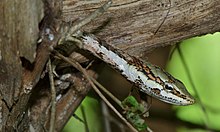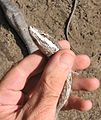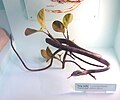Twig snake
| Twig snake | |
|---|---|

| |
| T. capensis in Kruger NP, South Africa | |
| Scientific classification | |
| Kingdom: | |
| Phylum: | |
| Subphylum: | |
| Class: | |
| Order: | |
| Suborder: | |
| Family: | |
| Subfamily: | |
| Genus: | Thelotornis |
| Species | |
The twig snakes (genus Thelotornis), also commonly known as bird snakes or vine snakes, are a genus of rear-fanged snakes in the family Colubridae. All species have slender and elongated profiles, long tails, narrow heads, and pointed snouts. The eyes of each species have horizontal pupils, shaped like keyholes, which give twig snakes binocular vision. Twig snakes are greyish-brown with faint light and dark markings. When threatened, they inflate their throats to display bold black markings between the scales.
Anatomy and behaviour
Twig snakes are among the few rear-fanged colubrids whose bite is highly venomous and potentially fatal.[3] The venom is hemotoxic, and although its effects are very slow, and bites are rare, no antivenom has been developed and several fatalities (such as Robert Mertens) have occurred. They prey on lizards, frogs, and sometimes birds, and conceal themselves in trees, though often at a low enough level to be able to also strike at terrestrial prey, which they may swallow upwards after killing. Their cryptic coloration and apparent ability to freeze or sway gently, as chameleons do, like a twig on a tree (hence the name), makes them hard to spot. Indeed, they may be more abundant in areas than is immediately obvious.
Description
The African twig snakes are distinctive in appearance and unlikely on that continent to be mistaken for any other snake, if indeed the observer notices them. Thelotornis is characterised by a depressed and flat head, keyhole-shaped pupils, and in T. kirtlandii, a projecting canthus rostralis which forms a shallow loreal groove on each side of the head, which allows some binocular vision. In appearance, the head at least is unlikely to be mistaken for any other African snake. Other characteristics include a very long tail and large back fangs. The iris in T. capensis and T. kirtlandii is yellow, and presumably therefore also in T. usambaricus.
Etymology
The specific name, kirtlandii, is in honor of American naturalist Jared Potter Kirtland.[4]
Gallery
-
T. capensis -
T. mossambicanus -
T. kirtlandii
References
- ^ "Thelotornis ". Dahms Tierleben. www.dahmstierleben.de/systematik/Reptilien/Squamata/Serpentes/colubroidea/colubridae/colubrinae.
- ^ "Thelotornis ". The Reptile Database. www.reptile-database.org.
- ^ Goin CJ, Goin OB, Zug GR. 1978. Introduction to Herpetology, Third Edition. San Francisco: W.H. Freeman. xi + 387 pp. ISBN 0-7167-0020-4. ("Thelotornis kirtlandi [sic]", p. 322).
- ^ Beolens B, Watkins M, Grayson M. 2011. The Eponym Dictionary of Reptiles. Baltimore: Johns Hopkins University Press. xiii + 296 pp. ISBN 978-1-4214-0135-5. ("Thelotornis kirtlandi [sic]", p. 142).
Further reading
- Boulenger GA. 1896. Catalogue of the Snakes in the British Museum (Natural History). Volume III., Containing the Colubridæ (Opisthoglyphæ and Proteroglyphæ) ... London: Trustees of the British Museum (Natural History). (Taylor and Francis, printers). xiv + 727 pp. + Plates I-XXV. (Genus Thelotornis, pp. 184–185).
- Branch, Bill. 2004. Field Guide to Snakes and other Reptiles of Southern Africa. Sanibel Island, Florida: Ralph Curtis Books. 399 pp. ISBN 0-88359-042-5. (Genus Thelotornis, p. 100).
- Smith A. 1849. Illustrations of the zoology of South Africa, Reptilia. London: Smith, Elder, and Co. (Thelotornis, new genus).




